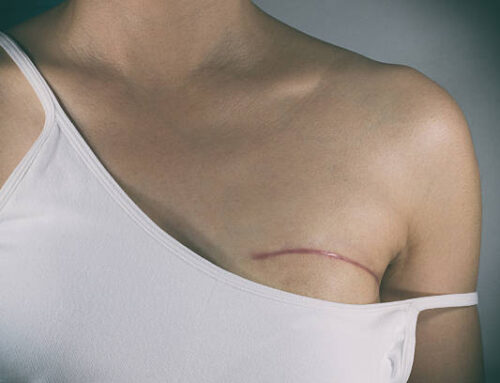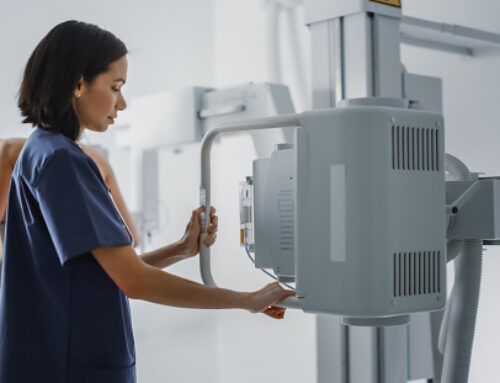Any type of lump or mass felt in a breast can be alarming. Here, we discuss what you should know about breast cysts.
A breast cyst is a benign condition that involves the development of one or more fluid-filled sacs in the breast tissue. This is a very common condition, particularly for women transitioning through peri-menopause, between age 35 and 50. After menopause, unless a woman is taking hormone replacement therapy, the likelihood of breast cysts is very low.
Cysts develop in the area between the milk ducts and the milk-producing glands. They may be so small that they are never discovered, except through mammography. Cysts can also be large enough to feel during a routine self-exam. A cyst may feel soft, like a water-balloon, or it may feel firm. Furthermore, a cyst may change over time. Additional cysts may form in one or both breasts. A cyst may increase or decrease in size. It may resolve and no longer be felt. These variances can make it difficult for a woman to avoid unnecessary worry. This is why it is important to schedule a breast exam when any type of abnormality is felt.
What Not to Do When You Have a Breast Cyst
Once a woman knows that her lumps are non-cancerous fluid-filled cysts, she may assume that any change in breast tissue, such as new lumps, is also cystic. While this is very likely true, a new lump must be examined by a doctor. A breast cyst will not become cancerous. However, cancerous tumors can develop near a cyst or elsewhere on the breast. Women with breast cysts should not stop performing self-exams each month. They should not stop seeing their doctor for an annual exam or breast exam of new lumps. Women also do not need to have their cysts drained or removed. However, they may choose to do so. The most common reason women choose to have breast cysts treated is pain.
What You Can Do About Breast Cysts
Breast cysts are not preventable nor are they curable. However, some women report a decrease in symptoms following various lifestyle changes, such as:
- Discontinuing hormone replacement therapy
- Eliminating caffeine
- Eliminating red meat
- Decreasing salt consumption
- Wearing a supportive bra
One of the benefits of high-quality mammography is that this screening can restore peace of mind for women with breast cysts.
1. What are breast cysts?
Breast cysts are a benign (not cancer) condition. They’re one of the most common causes of a breast lump, and can develop in either one or both breasts. It’s thought they develop naturally as the breast changes with age due to normal changes in hormone levels. It’s common to have more than one cyst.
2. What are the symptoms of breast cysts?
Breast cysts can feel soft or hard and can be any size, ranging from a few millimetres to several centimetres. They’re usually oval or round in shape and can develop quickly anywhere in the breast. For some people, cysts can feel uncomfortable and even painful. Before a period, cysts may become larger and feel sore and tender as hormone levels change. However, many women can have cysts and not be able to feel them at all.
Although much more common in women, men can also get breast cysts.
3. What causes breast cysts?
Breasts are made up of lobules (milk-producing glands) and ducts (tubes that carry milk to the nipple). The milk glands are surrounded by fibrous support tissue and fat, known as breast tissue. This tissue gives breasts their size and shape. Sometimes, the milk glands can fill up with fluid; these are breast cysts.
Cysts may appear naturally as the breast alters with age, due to normal changes in the oestrogen hormone levels. During the menstrual cycle oestrogen causes fluid to be produced. Although you can develop breast cysts at any age, they’re most common in women over 35.
After the menopause (when your periods stop), as oestrogen levels fall, cysts usually stop forming. Women who have hormone replacement therapy (HRT) may still get cysts.

4. How are breast cysts found?
Cysts usually become noticeable as a lump in the breast or are found by chance during a routine screening mammogram (breast x-ray) or while having investigations at a breast clinic for another reason.
If you see your GP because you have found a breast lump, they’ll sometimes be able to say whether it feels like a cyst. However, they’re still likely to refer you to a breast clinic where you’ll be seen by specialist doctors or nurses and have further tests.
Diagnosing breast cysts
At the breast clinic you’ll have a breast examination. You may also have a mammogram or ultrasound scan (using sound waves to produce an image of the breast), or both. Ultrasounds can help to find out if a lump is solid or fluid-filled, such as a benign cyst.
If you’re under 40 you’re more likely to have an ultrasound than a mammogram. Younger women’s breast tissue can be dense, which can make the x-ray image less clear so normal changes or benign conditions can be harder to identify. However, for some women under 40 mammograms may still be needed to complete the assessment.
If the lump can be easily felt, your specialist may put a fine needle into it and draw off the fluid to confirm that it’s a fluid-filled cyst.
You can call our free Helpline on 0808 800 6000 if you’d like more information about any tests you may be having.
5. Treatment and follow-up
If you do have a breast cyst or cysts, you will not usually need any treatment or follow-up. Most cysts go away by themselves and are nothing to worry about.
If the cyst is large or causing discomfort, your specialist may draw off the fluid using a fine needle and syringe. Sometimes this is done using ultrasound to help find the cyst. The fluid can vary in colour and range from clear to very dark. If the fluid is blood-stained, it will be sent to a laboratory for testing.
Once the fluid is removed, the cyst usually disappears. You might feel some discomfort as the fluid is being drawn off, and the area may feel bruised and tender for some days afterwards. If so, taking pain relief like paracetamol should help.
Breast cysts can come back or you may develop new cysts. The treatment for cysts is usually the same each time. You should see your GP if you think your cyst has returned or you think you have a new one.
6. Can breast cysts be prevented?
Cysts happen in response to normal female hormones and there’s no known way to prevent them. Having HRT can increase the risk of developing new cysts.
7. Does a breast cyst increase my risk of breast cancer?
You may feel anxious about having a breast cyst or cysts. Even though you may be relieved that it’s a benign condition, you may still worry about breast cancer.
Having a breast cyst or cysts does not increase your risk of developing breast cancer in the future. However, it’s still important to be breast aware and go back to your GP if you notice any changes in your breasts, regardless of how soon these occur after your cyst or cysts were diagnosed.




